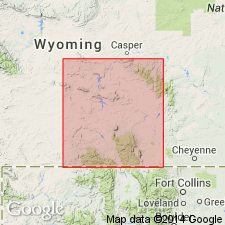
- Usage in publication:
-
- Sybille tongue
- Modifications:
-
- Named
- Dominant lithology:
-
- Sandstone
- AAPG geologic province:
-
- Green River basin
- Wind River basin
Summary:
Named as a tongue of Phosphoria formation for development around Sybille anticline near Sybille Springs, Albany Co, WY in Greater Green River basin. No type locality designated. Consists of a lower orange-buff (tan weathering), thin-bedded, limy sandstone with maroon chert laminae, and small angular, gray chert masses that grades upward into a massive, medium-grained, mottled, pink to buff sandstone with many cylindrical, gray, randomly oriented chert nodules that average about half an inch in diameter. Has occasional calcite geodes. Cross sections. Measured sections. Is 12.5 ft thick along Casper Creek, 17.7 ft thick at Alcova, 17.5 ft thick at Difficulty, and 18.8 ft thick at Cottonwood Creek, an area covering Albany and Carbon Cos, and into Natrona and Fremont Cos in the Wind River basin. Overlies and underlies unnamed parts of the Phosphoria. Tongues into Satanka shale. Age of Phosphoria [and thus Sybille] is in doubt, but is probably Permian.
Source: GNU records (USGS DDS-6; Denver GNULEX).
For more information, please contact Nancy Stamm, Geologic Names Committee Secretary.
Asterisk (*) indicates published by U.S. Geological Survey authors.
"No current usage" (†) implies that a name has been abandoned or has fallen into disuse. Former usage and, if known, replacement name given in parentheses ( ).
Slash (/) indicates name conflicts with nomenclatural guidelines (CSN, 1933; ACSN, 1961, 1970; NACSN, 1983, 2005, 2021). May be explained within brackets ([ ]).

